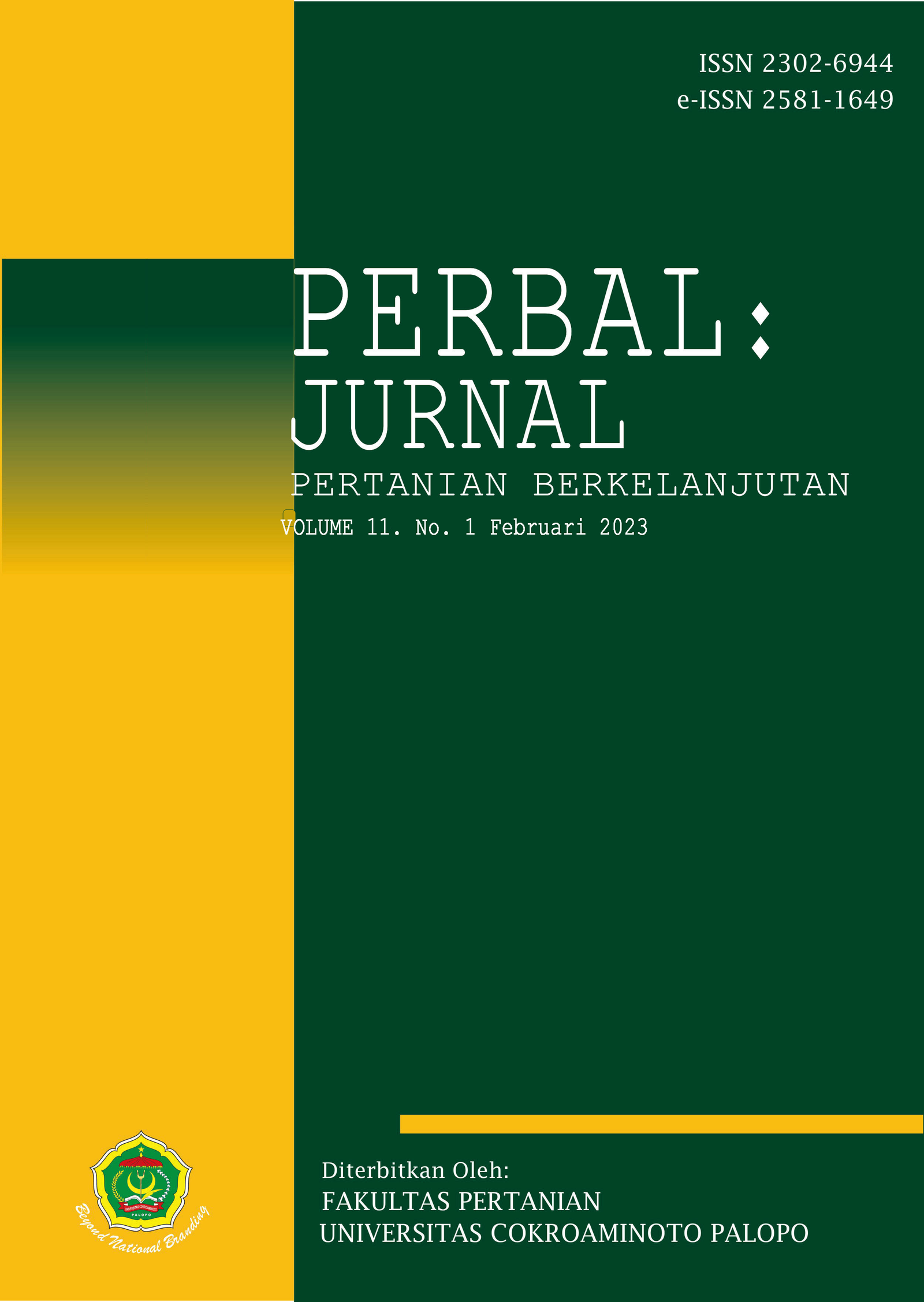Analisis Risiko Usahatani Nilam di Desa Karya Bhakti Kecamatan Kulisusu Barat Kabupaten Buton Utara
DOI:
https://doi.org/10.30605/perbal.v11i1.2256Abstract
Patchouli plants have high economic value, but patchouli plants have farming risks faced by farmers. The purpose of this research is to identify the risk at each stage of patchouli farming and to analyze the magnitude of the risk in patchouli farming. The population in this study were all 105 patchouli farmers. Determination of the sample in this study was carried out by simple random sampling totaling 51 farmers using the slovin formula. The variables observed in this study were the characteristics of the respondents: age, education level, number of dependents, land area, and farming experience. Farm risk: risk occurrence, risk frequency, risk source, risk qualitative impact, risk quantitative impact, risk magnitude, and risk classification. The data analysis used in this research is descriptive qualitative. The results of the study indicate that the risks that occur during land processing are that there are no tools and materials and work accidents. At the time of planting the risk that occurs is rotting plants. During maintenance, the risks that occur are aphids, stunted plants, elephantiasis and root rot. At the time of harvesting the risk that occurs is crop failure. The magnitude of the risk during land cultivation is moderate, at the time of planting, the magnitude of the risk is high, during maintenance, the magnitude of the risk is high and at the time of harvesting the magnitude of the risk is moderate.
Keywords: farming, patchouli, risk
Downloads
References
BPS Butur. (2020). Kabupaten Buton Utara dalam Angka 2020. Buton Utara.
Dewi, K. (2015). Analisis Risiko Usahatani Kedelai di Kecamatan Jawai Selatan Kabupaten Sambas. Jurnal Manajemen Motivasi. 10(2):317-324.
Hernanto, F. (1989). Ilmu Usaha Tani. Jakarta: Penebar Swadaya.
Musta’inah, A., Hani, E. S., & Sudarko, S. (2017). Analisis Risiko pada Usahatani Tomat di Kecamatan Ledokombo Kabupaten Jember. urnal Agribest, 1(2):136-151.
Nurdiana, N., & Nursalam, N. (2021). Risk Analysis of Rice Farming in Polenga Village, Watubangga District, Kolaka Regency. Agribusiness Journal. 4(1):40-43.
Nurzaimah. (2016). Analisis Pendapatan pada Usaha Tani Nilam di Desa Lhok Guci Kecamatan Pasi Raya Kabupaten Aceh Jaya. [Skripsi]. Universitas Teuku Umar Meulaboh.
Prasetyo, B., & Janah, L. M. (2005). Metode Penelitian Kuantitatif Teori dan Aplikasi. Jakarta: PT. Raja Grafindo Persada.
Prawoto, A., & Sholeh, M. (2006). Produksi Awal dan Kajian Ekonomis Usahatani Nilam Aceh (pogostemon cablin Benth) sebagai Tanaman Sela Kakao Muda. Jurnal Pelita Perkebunan. 22(3):68-190.
PT. Hutama. (2021). Manajemen Risiko Madya dan Sertifikasi Nasional Bergelar Profesi Lisensi BNSP.
Soeharjo, A., & Patong, D. (1973). Sendi-sendi pokok ilmu usahatani. Bogor: Institut Pertanian Bogor.
Downloads
Published
Issue
Section
License
In submitting the manuscript to the journal, the authors certify that:
- They are authorized by their co-authors to enter into these arrangements.
- The work described has not been formally published before, except in the form of an abstract or as part of a published lecture, review, thesis, or overlay journal.
- That it is not under consideration for publication elsewhere,
- That its publication has been approved by all the author(s) and by the responsible authorities – tacitly or explicitly – of the institutes where the work has been carried out.
- They secure the right to reproduce any material that has already been published or copyrighted elsewhere.
- They agree to the following license and copyright agreement.
License and Copyright Agreement
Authors who publish with Onoma Journal: Education, Languages??, and Literature agree to the following terms:
- Authors retain copyright and grant the journal right of first publication with the work simultaneously licensed under Creative Commons Attribution License (CC BY 4.0) that allows others to share the work with an acknowledgment of the work's authorship and initial publication in this journal.
- Authors are able to enter into separate, additional contractual arrangements for the non-exclusive distribution of the journal's published version of the work (e.g., post it to an institutional repository or publish it in a book), with an acknowledgment of its initial publication in this journal.
- Authors are permitted and encouraged to post their work online (e.g., in institutional repositories or on their website) prior to and during the submission process, as it can lead to productive exchanges, as well as earlier and greater citation of published work.

